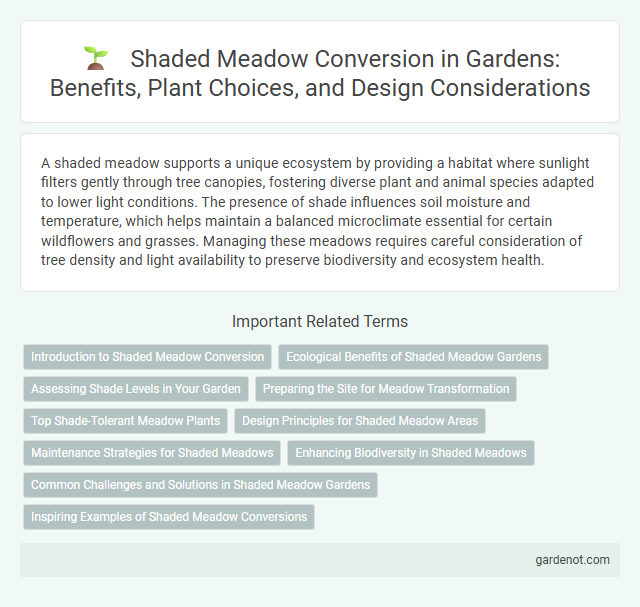A shaded meadow supports a unique ecosystem by providing a habitat where sunlight filters gently through tree canopies, fostering diverse plant and animal species adapted to lower light conditions. The presence of shade influences soil moisture and temperature, which helps maintain a balanced microclimate essential for certain wildflowers and grasses. Managing these meadows requires careful consideration of tree density and light availability to preserve biodiversity and ecosystem health.
Introduction to Shaded Meadow Conversion
Shaded meadow conversion transforms low-light, tree-covered areas into vibrant habitats by selectively managing canopy density and encouraging shade-tolerant native grasses and wildflowers. This process enhances biodiversity, supports pollinators, and improves ecosystem resilience in previously underutilized woodland patches. Effective shaded meadow conversion relies on tailored planting strategies and ongoing habitat monitoring to balance light availability with species diversity.
Ecological Benefits of Shaded Meadow Gardens
Shaded meadow gardens enhance biodiversity by providing habitat for shade-tolerant flora and fauna, supporting pollinators and beneficial insects that thrive in low-light environments. These gardens improve soil health by increasing organic matter through leaf litter decomposition, aiding nutrient cycling and moisture retention. By mitigating urban heat island effects, shaded meadows contribute to microclimate regulation and reduce energy consumption for cooling.
Assessing Shade Levels in Your Garden
Assessing shade levels in your garden is essential for successful shaded meadow conversion, as it determines plant selection and growth performance. Use tools like light meters or observe sunlight patterns throughout the day to identify areas of deep, partial, or dappled shade. Understanding the specific shade conditions allows for choosing shade-tolerant native grasses and wildflowers that will thrive in less direct sunlight, ensuring a sustainable and vibrant meadow ecosystem.
Preparing the Site for Meadow Transformation
Preparing the site for shaded meadow conversion involves assessing soil quality, ensuring appropriate moisture levels, and selecting shade-tolerant native species. Clearing invasive plants and reducing canopy density enhance light availability, promoting healthy meadow growth under shaded conditions. Proper site preparation maximizes biodiversity and supports ecosystem resilience in shaded meadow environments.
Top Shade-Tolerant Meadow Plants
Top shade-tolerant meadow plants such as Solomon's seal (Polygonatum), bluebells (Hyacinthoides non-scripta), and wood anemone (Anemone nemorosa) thrive in shaded meadow environments by adapting to lower light levels. These species support biodiversity by providing nectar and habitat for pollinators and woodland wildlife within shaded meadow conversions. Selecting native, shade-adapted plants ensures sustainable growth and ecological balance in shaded meadow restoration projects.
Design Principles for Shaded Meadow Areas
Shaded meadow design prioritizes selecting shade-tolerant native grasses and wildflowers that thrive under canopy cover, ensuring biodiversity and sustainability. Incorporating soil analysis and moisture-retentive amendments enhances plant establishment in low-light conditions. Strategic placement of plant clusters mimics natural shade gradients, optimizing growth and seasonal visual interest.
Maintenance Strategies for Shaded Meadows
Shaded meadows require tailored maintenance strategies that prioritize selective pruning to enhance light penetration while preserving canopy integrity. Soil aeration and mulching techniques support root health by mitigating compaction and retaining moisture in low-light conditions. Regular monitoring of shade-tolerant grass species and invasive plants ensures sustainable growth and biodiversity within shaded meadow ecosystems.
Enhancing Biodiversity in Shaded Meadows
Shaded meadows create unique microhabitats that support a diverse range of flora and fauna, contributing significantly to local biodiversity. Incorporating shade-tolerant native plants and maintaining varied vegetation layers fosters habitat complexity, essential for pollinators, birds, and small mammals. Effective management practices in shaded meadows enhance ecological resilience and strengthen ecosystem services such as soil stabilization and nutrient cycling.
Common Challenges and Solutions in Shaded Meadow Gardens
Shaded meadow gardens often face challenges such as limited sunlight, which inhibits the growth of sun-loving species and can lead to sparse vegetation and increased weed invasion. Selecting shade-tolerant native plants like ferns, Solomon's seal, and woodland wildflowers enhances biodiversity and promotes soil stability. Implementing strategic thinning of overhanging canopy and improving soil conditions with organic mulch further optimizes plant health and ecosystem resilience in shaded meadow environments.
Inspiring Examples of Shaded Meadow Conversions
Shaded meadow conversions transform underutilized shadowed areas into vibrant ecosystems by planting shade-tolerant native wildflowers and grasses, enhancing biodiversity and soil health. Notable examples include the conversion of woodland edges and urban parks where careful selection of species like foxglove and wood anemone thrives under canopy cover. These projects demonstrate how thoughtful design maximizes limited sunlight to create sustainable, visually striking shaded meadows that support pollinators and local wildlife.
Shaded meadow Infographic

 gardenot.com
gardenot.com